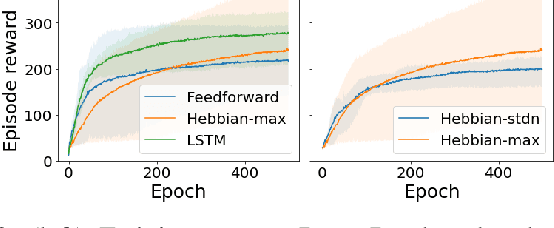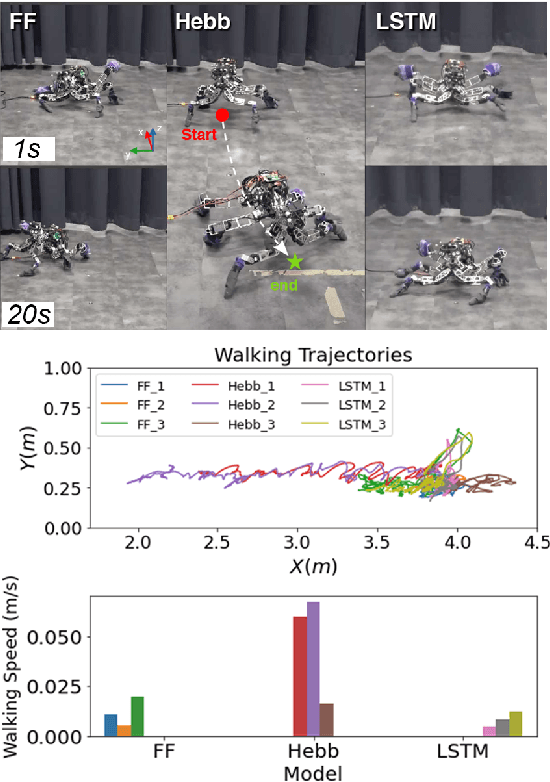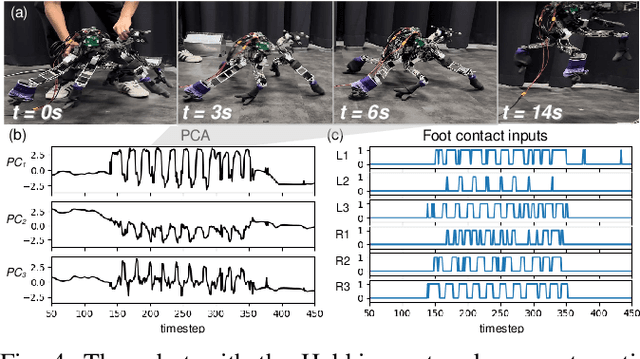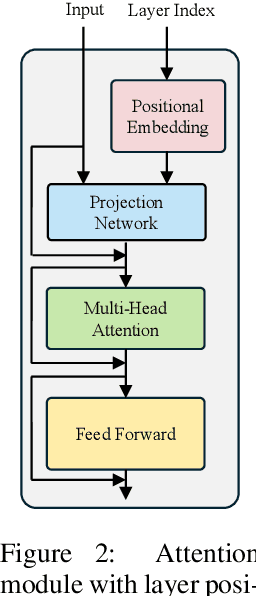Sebastian Risi
modl.ai
Solving Inverse Problems in Stochastic Self-Organising Systems through Invariant Representations
Jun 13, 2025Abstract:Self-organising systems demonstrate how simple local rules can generate complex stochastic patterns. Many natural systems rely on such dynamics, making self-organisation central to understanding natural complexity. A fundamental challenge in modelling such systems is solving the inverse problem: finding the unknown causal parameters from macroscopic observations. This task becomes particularly difficult when observations have a strong stochastic component, yielding diverse yet equivalent patterns. Traditional inverse methods fail in this setting, as pixel-wise metrics cannot capture feature similarities between variable outcomes. In this work, we introduce a novel inverse modelling method specifically designed to handle stochasticity in the observable space, leveraging the capacity of visual embeddings to produce robust representations that capture perceptual invariances. By mapping the pattern representations onto an invariant embedding space, we can effectively recover unknown causal parameters without the need for handcrafted objective functions or heuristics. We evaluate the method on two canonical models--a reaction-diffusion system and an agent-based model of social segregation--and show that it reliably recovers parameters despite stochasticity in the outcomes. We further apply the method to real biological patterns, highlighting its potential as a tool for both theorists and experimentalists to investigate the dynamics underlying complex stochastic pattern formation.
When Does Neuroevolution Outcompete Reinforcement Learning in Transfer Learning Tasks?
May 28, 2025Abstract:The ability to continuously and efficiently transfer skills across tasks is a hallmark of biological intelligence and a long-standing goal in artificial systems. Reinforcement learning (RL), a dominant paradigm for learning in high-dimensional control tasks, is known to suffer from brittleness to task variations and catastrophic forgetting. Neuroevolution (NE) has recently gained attention for its robustness, scalability, and capacity to escape local optima. In this paper, we investigate an understudied dimension of NE: its transfer learning capabilities. To this end, we introduce two benchmarks: a) in stepping gates, neural networks are tasked with emulating logic circuits, with designs that emphasize modular repetition and variation b) ecorobot extends the Brax physics engine with objects such as walls and obstacles and the ability to easily switch between different robotic morphologies. Crucial in both benchmarks is the presence of a curriculum that enables evaluating skill transfer across tasks of increasing complexity. Our empirical analysis shows that NE methods vary in their transfer abilities and frequently outperform RL baselines. Our findings support the potential of NE as a foundation for building more adaptable agents and highlight future challenges for scaling NE to complex, real-world problems.
Adversarial Coevolutionary Illumination with Generational Adversarial MAP-Elites
May 10, 2025Abstract:Unlike traditional optimization algorithms focusing on finding a single optimal solution, Quality-Diversity (QD) algorithms illuminate a search space by finding high-performing solutions that cover a specified behavior space. However, tackling adversarial problems is more challenging due to the behavioral interdependence between opposing sides. Most applications of QD algorithms to these problems evolve only one side, thus reducing illumination coverage. In this paper, we propose a new QD algorithm, Generational Adversarial MAP-Elites (GAME), which coevolves solutions by alternating sides through a sequence of generations. Combining GAME with vision embedding models enables the algorithm to directly work from videos of behaviors instead of handcrafted descriptors. Some key findings are that (1) emerging evolutionary dynamics sometimes resemble an arms race, (2) starting each generation from scratch increases open-endedness, and (3) keeping neutral mutations preserves stepping stones that seem necessary to reach the highest performance. In conclusion, the results demonstrate that GAME can successfully illuminate an adversarial multi-agent game, opening up interesting future directions in understanding the emergence of open-ended coevolution.
Continuous Thought Machines
May 08, 2025



Abstract:Biological brains demonstrate complex neural activity, where the timing and interplay between neurons is critical to how brains process information. Most deep learning architectures simplify neural activity by abstracting away temporal dynamics. In this paper we challenge that paradigm. By incorporating neuron-level processing and synchronization, we can effectively reintroduce neural timing as a foundational element. We present the Continuous Thought Machine (CTM), a model designed to leverage neural dynamics as its core representation. The CTM has two core innovations: (1) neuron-level temporal processing, where each neuron uses unique weight parameters to process a history of incoming signals; and (2) neural synchronization employed as a latent representation. The CTM aims to strike a balance between oversimplified neuron abstractions that improve computational efficiency, and biological realism. It operates at a level of abstraction that effectively captures essential temporal dynamics while remaining computationally tractable for deep learning. We demonstrate the CTM's strong performance and versatility across a range of challenging tasks, including ImageNet-1K classification, solving 2D mazes, sorting, parity computation, question-answering, and RL tasks. Beyond displaying rich internal representations and offering a natural avenue for interpretation owing to its internal process, the CTM is able to perform tasks that require complex sequential reasoning. The CTM can also leverage adaptive compute, where it can stop earlier for simpler tasks, or keep computing when faced with more challenging instances. The goal of this work is to share the CTM and its associated innovations, rather than pushing for new state-of-the-art results. To that end, we believe the CTM represents a significant step toward developing more biologically plausible and powerful artificial intelligence systems.
Bio-Inspired Plastic Neural Networks for Zero-Shot Out-of-Distribution Generalization in Complex Animal-Inspired Robots
Mar 16, 2025



Abstract:Artificial neural networks can be used to solve a variety of robotic tasks. However, they risk failing catastrophically when faced with out-of-distribution (OOD) situations. Several approaches have employed a type of synaptic plasticity known as Hebbian learning that can dynamically adjust weights based on local neural activities. Research has shown that synaptic plasticity can make policies more robust and help them adapt to unforeseen changes in the environment. However, networks augmented with Hebbian learning can lead to weight divergence, resulting in network instability. Furthermore, such Hebbian networks have not yet been applied to solve legged locomotion in complex real robots with many degrees of freedom. In this work, we improve the Hebbian network with a weight normalization mechanism for preventing weight divergence, analyze the principal components of the Hebbian's weights, and perform a thorough evaluation of network performance in locomotion control for real 18-DOF dung beetle-like and 16-DOF gecko-like robots. We find that the Hebbian-based plastic network can execute zero-shot sim-to-real adaptation locomotion and generalize to unseen conditions, such as uneven terrain and morphological damage.
Human-like Bots for Tactical Shooters Using Compute-Efficient Sensors
Dec 30, 2024Abstract:Artificial intelligence (AI) has enabled agents to master complex video games, from first-person shooters like Counter-Strike to real-time strategy games such as StarCraft II and racing games like Gran Turismo. While these achievements are notable, applying these AI methods in commercial video game production remains challenging due to computational constraints. In commercial scenarios, the majority of computational resources are allocated to 3D rendering, leaving limited capacity for AI methods, which often demand high computational power, particularly those relying on pixel-based sensors. Moreover, the gaming industry prioritizes creating human-like behavior in AI agents to enhance player experience, unlike academic models that focus on maximizing game performance. This paper introduces a novel methodology for training neural networks via imitation learning to play a complex, commercial-standard, VALORANT-like 2v2 tactical shooter game, requiring only modest CPU hardware during inference. Our approach leverages an innovative, pixel-free perception architecture using a small set of ray-cast sensors, which capture essential spatial information efficiently. These sensors allow AI to perform competently without the computational overhead of traditional methods. Models are trained to mimic human behavior using supervised learning on human trajectory data, resulting in realistic and engaging AI agents. Human evaluation tests confirm that our AI agents provide human-like gameplay experiences while operating efficiently under computational constraints. This offers a significant advancement in AI model development for tactical shooter games and possibly other genres.
Harnessing Language for Coordination: A Framework and Benchmark for LLM-Driven Multi-Agent Control
Dec 16, 2024



Abstract:Large Language Models (LLMs) have demonstrated remarkable performance across various tasks. A promising but largely under-explored area is their potential to facilitate human coordination with many agents. Such capabilities would be useful in domains including disaster response, urban planning, and real-time strategy scenarios. In this work, we introduce (1) a real-time strategy game benchmark designed to evaluate these abilities and (2) a novel framework we term HIVE. HIVE empowers a single human to coordinate swarms of up to 2,000 agents using natural language dialog with an LLM. We present promising results on this multi-agent benchmark, with our hybrid approach solving tasks such as coordinating agent movements, exploiting unit weaknesses, leveraging human annotations, and understanding terrain and strategic points. However, our findings also highlight critical limitations of current models, including difficulties in processing spatial visual information and challenges in formulating long-term strategic plans. This work sheds light on the potential and limitations of LLMs in human-swarm coordination, paving the way for future research in this area. The HIVE project page, which includes videos of the system in action, can be found here: hive.syrkis.com.
Collective Innovation in Groups of Large Language Models
Jul 07, 2024



Abstract:Human culture relies on collective innovation: our ability to continuously explore how existing elements in our environment can be combined to create new ones. Language is hypothesized to play a key role in human culture, driving individual cognitive capacities and shaping communication. Yet the majority of models of collective innovation assign no cognitive capacities or language abilities to agents. Here, we contribute a computational study of collective innovation where agents are Large Language Models (LLMs) that play Little Alchemy 2, a creative video game originally developed for humans that, as we argue, captures useful aspects of innovation landscapes not present in previous test-beds. We, first, study an LLM in isolation and discover that it exhibits both useful skills and crucial limitations. We, then, study groups of LLMs that share information related to their behaviour and focus on the effect of social connectivity on collective performance. In agreement with previous human and computational studies, we observe that groups with dynamic connectivity out-compete fully-connected groups. Our work reveals opportunities and challenges for future studies of collective innovation that are becoming increasingly relevant as Generative Artificial Intelligence algorithms and humans innovate alongside each other.
LayerShuffle: Enhancing Robustness in Vision Transformers by Randomizing Layer Execution Order
Jul 05, 2024



Abstract:Due to their architecture and how they are trained, artificial neural networks are typically not robust toward pruning, replacing, or shuffling layers at test time. However, such properties would be desirable for different applications, such as distributed neural network architectures where the order of execution cannot be guaranteed or parts of the network can fail during inference. In this work, we address these issues through a number of proposed training approaches for vision transformers whose most important component is randomizing the execution order of attention modules at training time. We show that with our proposed approaches, vision transformers are indeed capable to adapt to arbitrary layer execution orders at test time assuming one tolerates a reduction (about 20\%) in accuracy at the same model size. We also find that our trained models can be randomly merged with each other resulting in functional ("Frankenstein") models without loss of performance compared to the source models. Finally, we layer-prune our models at test time and find that their performance declines gracefully.
Evolving Self-Assembling Neural Networks: From Spontaneous Activity to Experience-Dependent Learning
Jun 14, 2024Abstract:Biological neural networks are characterized by their high degree of plasticity, a core property that enables the remarkable adaptability of natural organisms. Importantly, this ability affects both the synaptic strength and the topology of the nervous systems. Artificial neural networks, on the other hand, have been mainly designed as static, fully connected structures that can be notoriously brittle in the face of changing environments and novel inputs. Building on previous works on Neural Developmental Programs (NDPs), we propose a class of self-organizing neural networks capable of synaptic and structural plasticity in an activity and reward-dependent manner which we call Lifelong Neural Developmental Program (LNDP). We present an instance of such a network built on the graph transformer architecture and propose a mechanism for pre-experience plasticity based on the spontaneous activity of sensory neurons. Our results demonstrate the ability of the model to learn from experiences in different control tasks starting from randomly connected or empty networks. We further show that structural plasticity is advantageous in environments necessitating fast adaptation or with non-stationary rewards.
 Add to Chrome
Add to Chrome Add to Firefox
Add to Firefox Add to Edge
Add to Edge